
5-31 #TooOld : Samsung is developing XR processor chips; Nvidia and MediaTek have said they will collaborate; realme may discontinue its sub-brand DIZO; etc.

Apple has recently filed a trademark for “SignChat” to provide sign language services. SignChat is a new accessibility service that provides info related to sign language. It is designed to help people who are deaf or hard of hearing to chat better and easily. From the reports so far, the service will include features such as video chat with sign language interpreters. It will also add sign language dictionaries and other features related to sign language. (GizChina, IT Home)
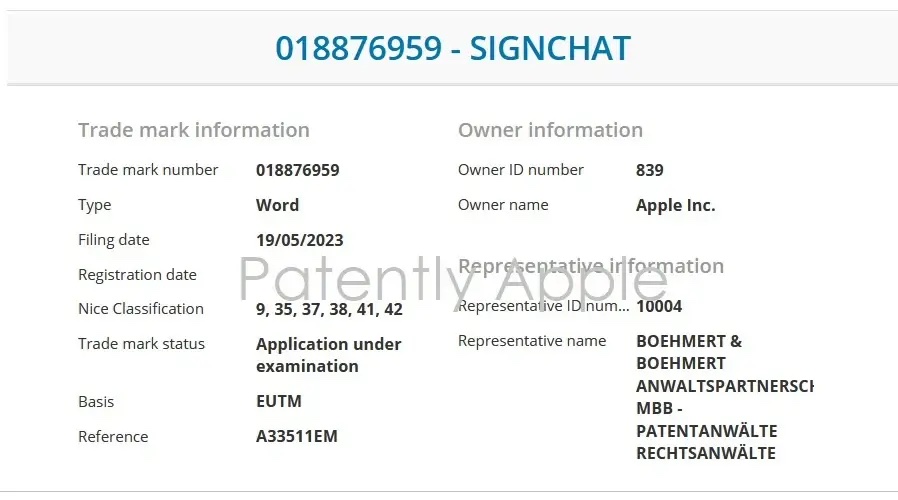
Xiaomi announces 2-year warranty extension for select phones in India. These devices are the Redmi Note 10 Pro, Redmi Note 10 Pro Max, Mi 11 Ultra, and Poco X3 Pro. The company is being very specific with the extension. Xiaomi may have identified some potential issues with certain phones and parts and is now working to address these issues.(Gizmo China, Digit.in, GSM Arena, Twitter)
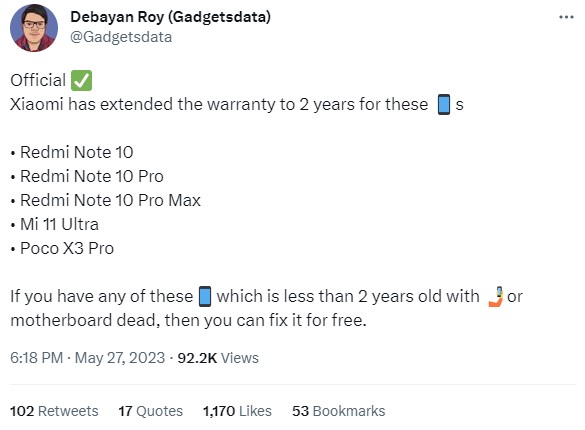
There are feelers that realme will discontinue its sub-brand DIZO after its CEO Abhilash Panda stepped down. realme had hyped the DIZO sub-brand when it was launched in 2021. The product lineup of DIZO included Bluetooth neckbands, hair dryers, trimmers, TWS earbuds, feature phones, and smartwatches. Specifically, from 2021 when it kicked off, DIZO has launched 17 smartwatches, 13 Bluetooth audio accessories, 1 hair dryer, 3 feature phones, and 3 hair trimmers. In Apr 2023, realme announced the overhaul of its Techlife brand which will now be under the Narzo sub-brand. DIZZO could also be likely subsumed under the Narzo brand. (Gizmo China, News18, The Mobile Indian)
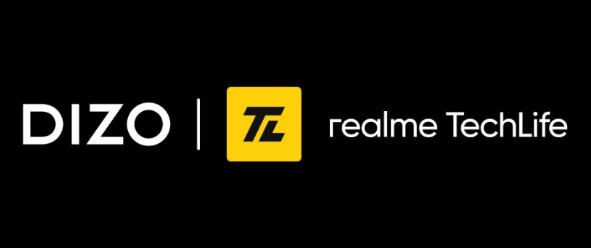
Samsung has launched Galaxy Self-Repair Program in South Korea, and as the name suggests, users will be able to repair their devices on their own by buying original parts straight from Samsung. Currently, Samsung is supporting the Galaxy S20, S21, and S22 series. At the same time, the Galaxy Book Pro series and Samsung TV model numbers; UN32N4000AFXKR, UN32N4010AFXKR, and UN32N4020AFXKR are also supported.(GSM Arena, Samsung, WCCFTech, Korea Herald)
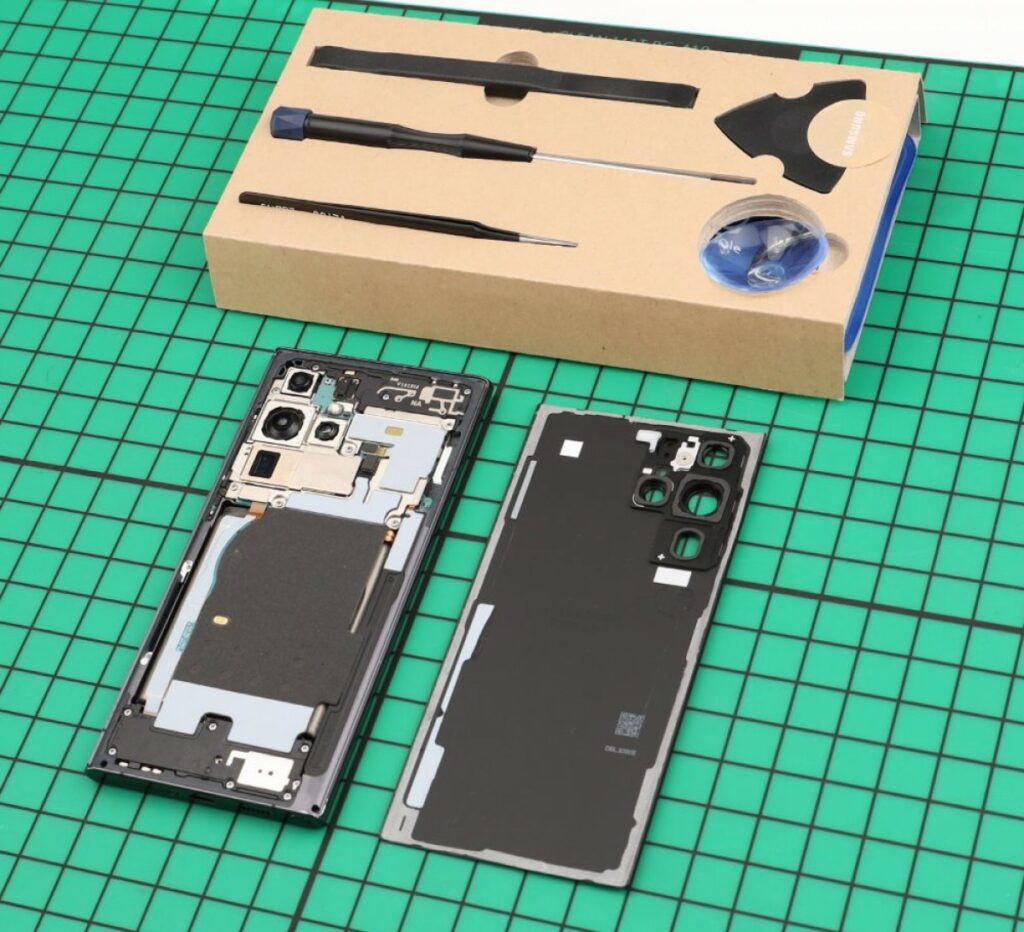
Samsung and other multinationals are reportedly pushing Vietnam to introduce a compensation scheme that would reimburse them for higher taxes expected starting on 1 Jan 2024 under new international tax rules. The reimbursement programme would be a way for the multinationals to continue operating at low cost in Vietnam after the introduction of a mandatory 15% minimum tax rate, introduced as a global reform led by the Organisation for Economic Cooperation and Development (OECD). Many of the multinationals that operate in Vietnam currently pay far less than that minimum, and Vietnam has agreed to effectively raise the tax rate to 15% to comply with the OECD rule. Under the OECD regime multinationals that pay less in a low-tax jurisdiction face a top-up levy in their home country.(CN Beta, Reuters, Silicon, XM)

Xiaomi India has signed up Optiemus Electronics to make Bluetooth audio products to broaden its manufacturing footprint in India to include products beyond smartphones and smart TVs. Optiemus will be making the company’s upcoming Bluetooth neckband earphones at its Noida facility. The electronics manufacturer, which also makes for Noise, Ambrane, and other brands, has dedicated a single assembly line with a capacity of 40,000 units per day, employing 70 people. Xiaomi also said that it is targeting a 50% increase in smartphone domestic value addition over the next two years and strengthen its position as a “key player” in the Indian electronics industry. The company has in the past claimed that 99% of its smartphones and 100% of its smart TVs sold in India are locally made.(Gizmo China, Reuters, Business Today, Economic Times, Mint)
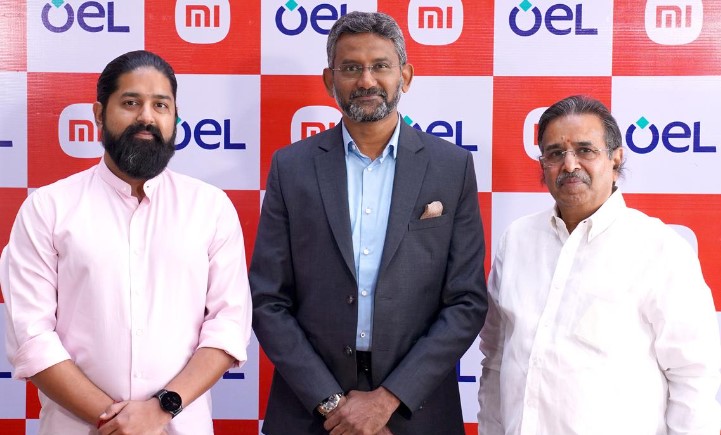

According to Wellsenn, the global VR shipments in 1Q23 were 1.82M units, a YoY decrease of 32% and a QoQ decrease of 47%. The decline was mainly due to the decline in sales of VR headset brands such as Meta and Pico. Among them, in 1Q23 China’s domestic VR headset shipments were 160,000 units, down 54% QoQ and 36% YoY; in 1Q23 overseas VR shipments were 1.66M units, down 46% QoQ and 34% YoY . Global VR shipments are expected to reach 11M units in 2023, an increase of 12% compared to 2022, including 7M units of Meta, 1.5M units of Sony PS VR2, 500,000 units of Pico, and 300,000 units of Apple MR. 2023 is still a year with relatively small shipments. In 2023, relatively heavyweight products such as Quest 3 and Apple MR will be released on the market, but they are expected to be launched in 4Q23, and it is difficult to make a large contribution to the annual sales. (TF Securities report)
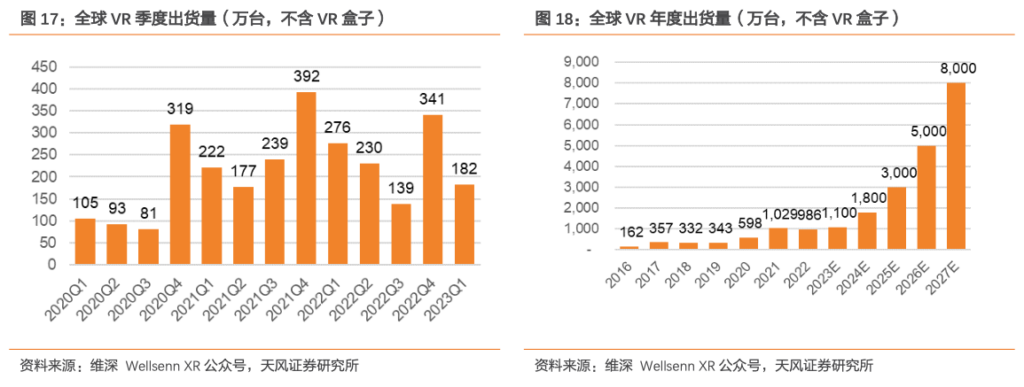
According to Wellsenn, the global AR headset shipments in 1Q23 were 97,000 units, a YoY increase of 18% and a QoQ decrease of 38%. Compared with 1Q22, the YoY growth in 1Q23 is mainly due to the continuous contribution of consumer-grade AR glasses, especially the sales contribution of viewing glasses such as Nreal, Thunderbird, Rokid, and Huawei. Among them, the shipment of AR headsets in the domestic market in 1Q23 was 32,000 units, a YoY increase of 39%; the shipment of AR headsets in the overseas market in 1Q23 was 65,000 units, a YoY increase of 10%. It is estimated that the global AR headset shipments in 2023 will be 650,000 units, an increase of 53% from 2022. The main growth contribution comes from the growth of consumer-grade AR glasses, especially from China’s Nreal, Rokid, Thunderbird, Huawei, Honor, Nubia and other brands of AR glasses for viewing movies, as well as information reminder AR glasses such as INMO, LAWK, QiDi Link is approaching, and Vuzix, etc. (TF Securities report)
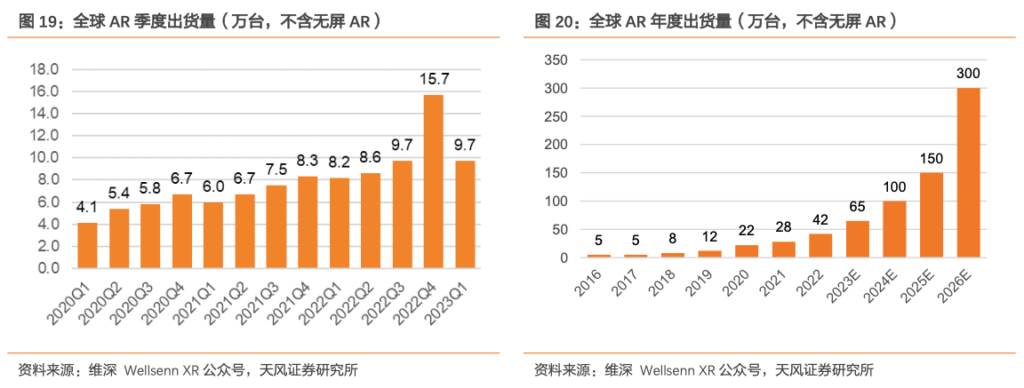
Apple’s first-generation MR headset “Reality Pro” has high-end hardware. According to The Information and VR Gyro, the Apple MR head display screens are two 1.4”, 4K-level high-resolution Micro-OLED screens, and the supplier is Sony; the chip is equipped with two processor chips based on the Apple M2, using 5nm made with advanced technology, it has been applied to MacBook Pro and other products; the optical solution adopts Pancake folding optical path, and the Fov reaches 120°; in terms of cameras and sensors, the Apple MR head display is equipped with more than ten cameras and sensors, one for each eye , to achieve eye tracking and foveated rendering functions, and also equipped with LiDAR sensors that are now used in iPhone and iPad devices to achieve SLAM and other functions. (China Securities report)
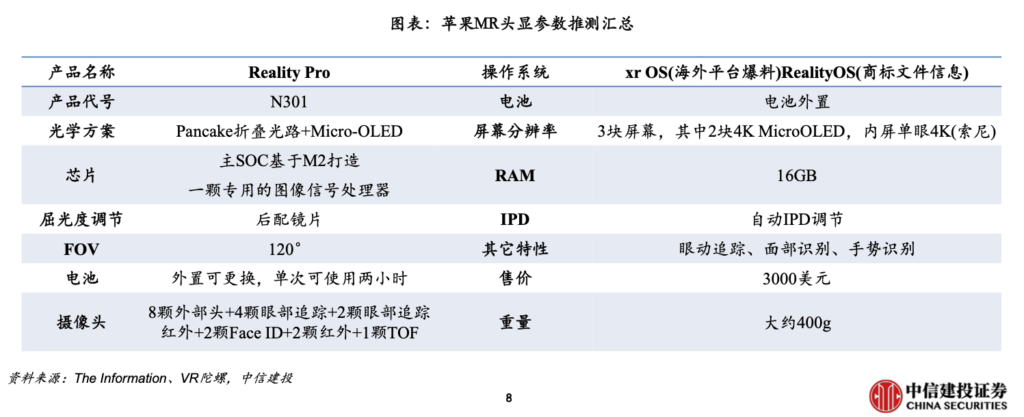

Huawei-backed premium EV brand AITO achieves the 100,000 shipment milestone. The 100,000th AITO Wenjie M5 smart driving version rolled off the production line, and it is the first “dual smart ceiling” model equipped with “smart driving ceiling” Huawei ADS 2.0 Huawei’s high-end smart driving system and “smart cockpit ceiling” HarmonyOS smart cockpit 3.0 . Richard Yu, CEO of Huawei’s Consumer Business Group (BG) and the Intelligent Automotive Solutions Business Unit (BU), has said that AITO Wenjie reached 100,000 vehicles off the assembly line in 15 months, which verified the success of the smart car model. From Jan- Mar 2023, the delivery volume of Wenjie was 4,475, 3,505, and 3,679 respectively, which is in stark contrast to the delivery of over 10,000 in 2022. According to the latest data released by AITO in apr, the delivery volume was 4,584 vehicles. On the one hand, it is affected by the “tide of price cuts”. However, in this regard, Yu said that in the long run, car companies that rely on price wars will find it difficult to survive, and only unqualified people will fight price wars. The real market competition has to improve its own competitiveness.(Laoyaoba, Laoyaoba, Yicai, Sina)
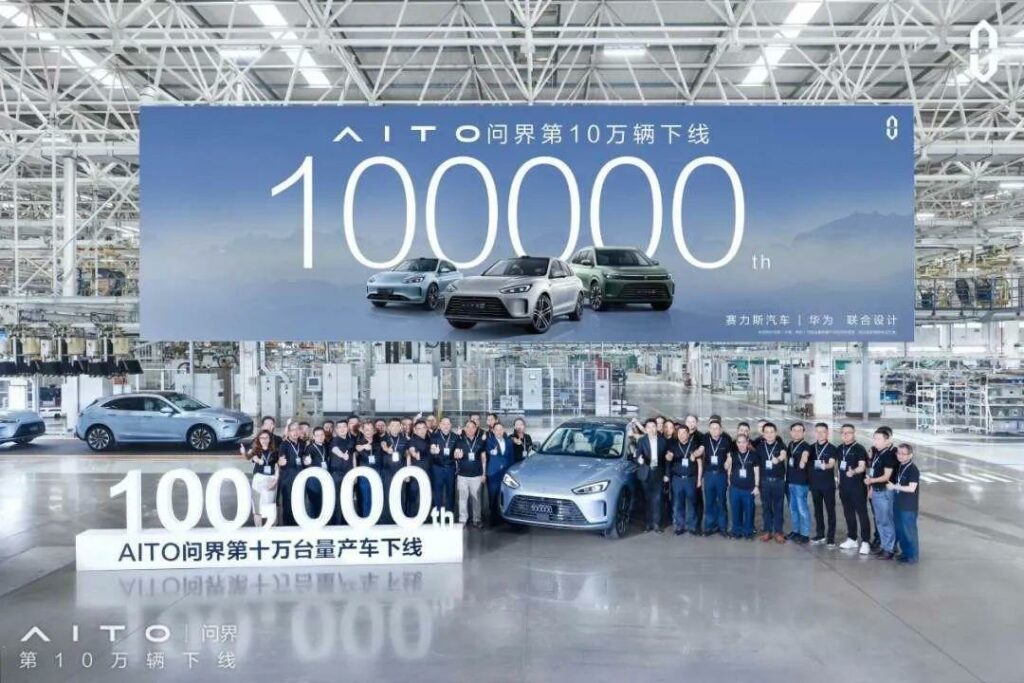

Google’s DeepMind (which recently absorbed a large chunk of Alphabet’s beleaguered Everyday Robots team) just issued a research paper outlining a potential benchmarking system to quantify the performance of quadrupeds. With a name like “Barkour,” one has to wonder whether the department worked backward from the title. Google Research points to the various impressive feats accomplished by quadrupeds over the years, from hiking up mountains to running and jumping, but there has not really been a baseline for determining system efficacy. Given that these machines are inspired by animals, the research team determined that real animals would provide the best performance analog for their robotic counterparts. That meant setting up an obstacle course in the lab and having a dog run it. The course was composed of four obstacles in a 5×5 meter area, which it notes is denser than the dog shows that inspired it. Performance is rated on a scale of 0 to 1 — a simple binary to determine whether the robot can successfully cross the space in the 10 or so seconds it takes for a similarly sized dog to do so.(CN Beta, TechCrunch)


According to Tianfeng Securities, based on the following assumptions, GPT currently spends at least USD347M on servers. First, suppose a server is composed of 2 CPUs, 8 GPUs (A100, 80G memory), DRAM and other components. This server can use the ChatGPT AI model to generate 15-20 words per second, taking 20 words/second, Then each server can generate 172.8M (= 20×60×60×24/10000) words per day. Assuming that the daily active user (DAU) is 10M, if each person only uses 500 words during the conversation, then ChatGPT needs to produce at least 5B words per day (=1000×5M, it should be noted here that the actual time spent by 10M people is not evenly distributed, so in reality ChatGPT can generate more than 5B words per day). The unit price of the CPU is USD5,000, the unit price of the GPU is USD11,500, and the unit price of the DRAM is USD8,000. Adding other components, the total price of a server is USD120,000. Based on the assumptions, the total cost of the server is USD347M, and the CPU, GPU, and DRAM are USD0.29M, USD266M, and USD23M, respectively. (TF Securities report)
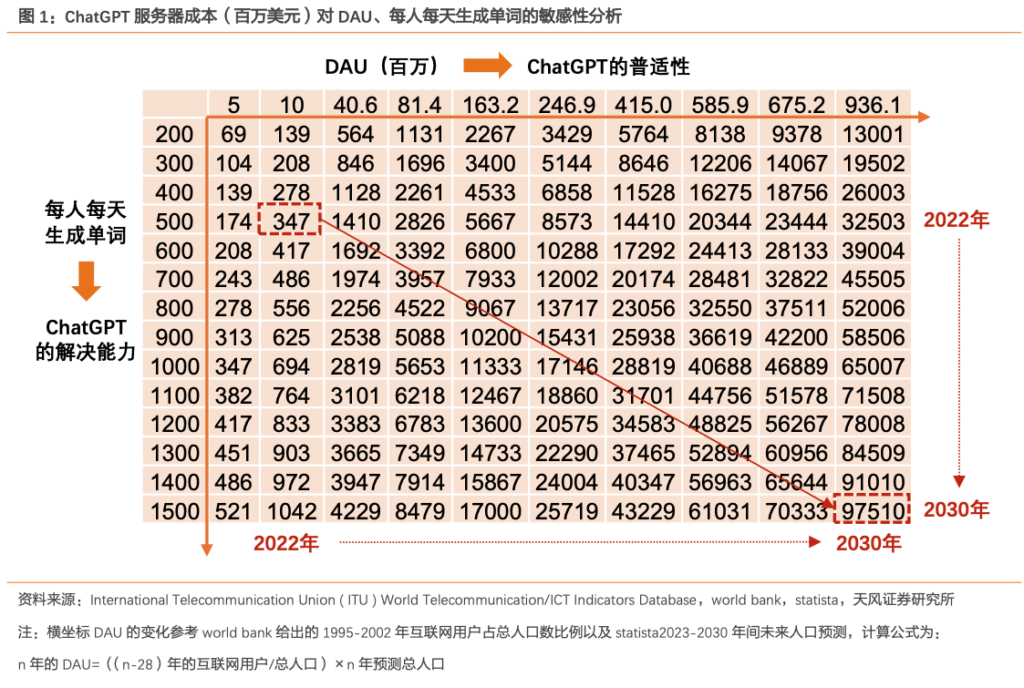

Arm has announced high-power Cortex-X4, middle Cortex-A720 and small Cortex-A520. Arm has revealed new DSU-120. A DSU (DynamIQ Shared Unit) “integrates one or more cores with an L3 memory system, control logic, and external interfaces to form a multicore cluster” meaning it is essentially the heart of a multi-core Arm-based System on Chip (SoC). The Cortex-X4 is designed to be used for the most demanding tasks and has the power to offer fast and precise computation it is needed. The Cortex-A720 can power through computing that demands it but does not require the horsepower of the Cortex-X4. The new Cortex-A520 does not require high-demand computing but it is still want a precise and efficient chip to perform the everyday tasks on the phone. (Android Central, Arm, GSM Arena, Arm, Arm, Arm)
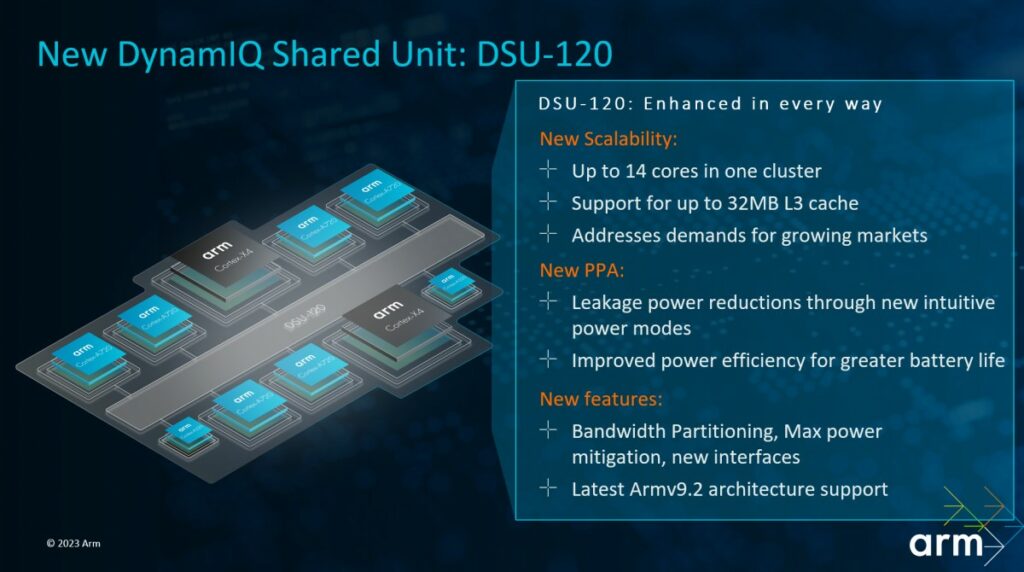

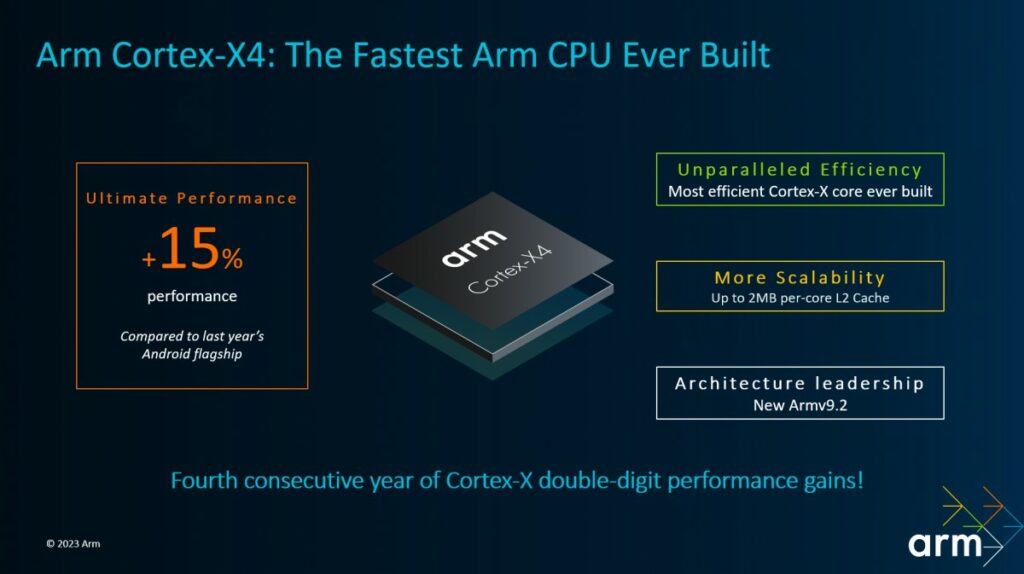

Samsung Electronics has been taking steps to develop extended reality (XR) device processor chips to challenge Qualcomm Technologies and Google. Samsung Mobile eXperience (MX) division early 2023 unveiled a plan to develop XR devices. Samsung is reportedly considering developing new processing units for extended reality products, or modifying the existing Exynos line of processors to suit XR devices. Early 2023, Samsung said it would collaborate with Qualcomm and Google to develop XR devices, independently of its System LSI Division within the company. (CN Beta, SamMobile, KED Global)
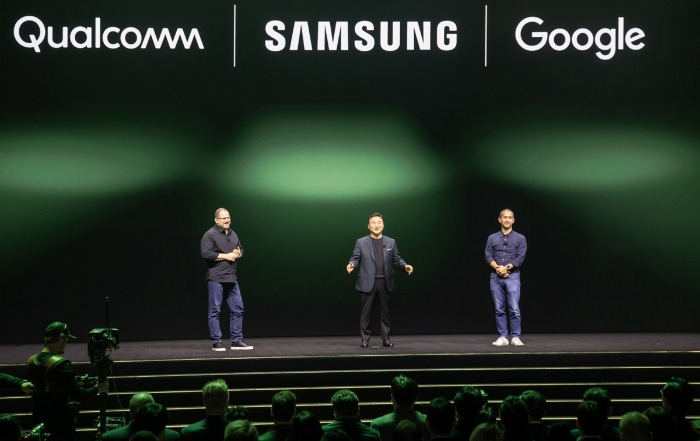
Nvidia and MediaTek have said they will collaborate on technology to power advanced vehicle infotainment systems that can stream video or games or interact with drivers using artificial intelligence. MediaTek will integrate an Nvidia graphic processing unit chiplet and Nvidia software into the system-on-chips it supplies to automakers for infotainment displays. MediaTek systems using Nvidia software would be compatible with automated driving systems based on Nvidia technology. Through this collaboration, MediaTek will develop automotive SoCs integrating a new Nvidia GPU chiplet with Nvidia AI and graphics IP. Chiplets are connected by an ultra-fast and coherent chiplet interconnect technology. MediaTek’s smart cabin solutions will run Nvidia DRIVE OS, DRIVE IX, CUDA and TensorRT software technologies — delivering a full range of AI cabin and cockpit functions with cutting-edge graphics, AI, safety and security features. (CN Beta, Nvidia, Reuters, MediaTek, Yahoo)
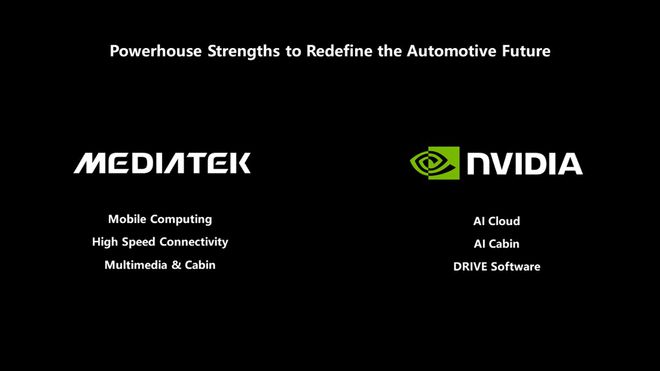
According to SEMI data, in 4Q22, semiconductor production capacity in mainland China accounted for 24% of the world’s total. This proportion has continued to increase since 2017. TF Securities believes that it may continue to increase in the future. In the new international environment, in order to maintain the security of China’s semiconductor supply chain, they believe that the domestic substitution ratio in semiconductor equipment materials and other fields is expected to continue to increase. With the continuous strategic expansion of domestic wafer foundries in mainland China, they believe that equipment material companies It is expected that more and more new products will be introduced to new customers and new production lines, thereby bringing new growth curves to related companies in the sector. They are optimistic about domestic alternative investment opportunities for semiconductor equipment and material companies in 2023. (TF Securities report)
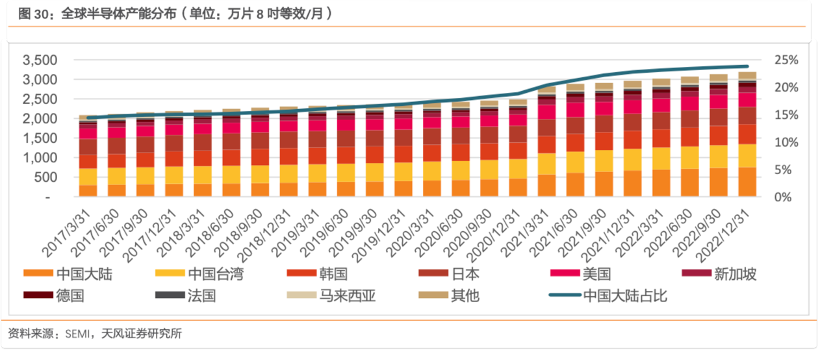
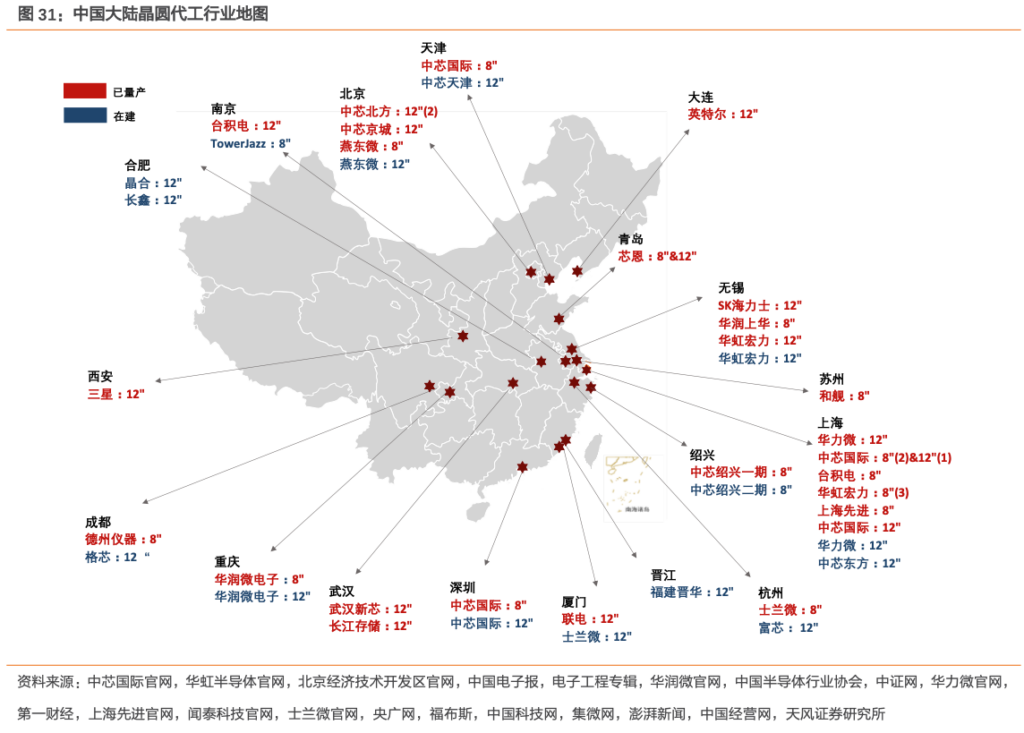

According to Bloomberg’s Mark Gurman, Apple’s iPhone 16 Pro and iPhone 16 Pro Max will feature larger display sizes. The size of its two “Pro” iPhone models from 6.1” and 6.7” by “a couple tenths of an inch diagonally”. The new display sizes would be the largest ever for the iPhone. Gurman noted that the change will make Apple’s high-end smartphones more competitive with the equivalent devices offered by Samsung. The increase could also create more internal space for improved hardware, such as camera technology and larger batteries. (GizChina, CN Beta, MacRumors, Bloomberg)
Google head of design for hardware products Ivy Ross has confirmed that the company was working on a second foldable phone, but it was cancelled. Ross has emphasized the company’s commitment to delivering a product that surpassed existing foldable offerings, leading them to hold back on its release. Google’s decision to scrap the second foldable Pixel highlights the company’s dedication to quality and innovation.(Neowin, Android Authority, Android Central, GSM Arena)
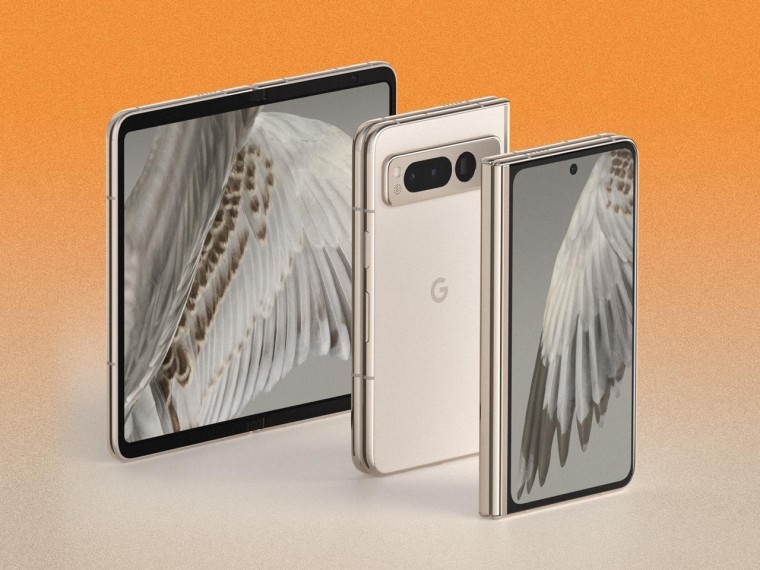
DSCC analyst Ross Young today shared some additional specifications of Apple’s AR / VR that give some insight into how the headset will work. Each of the two displays will measure in at 1.41” diagonally, with Apple aiming for over 5000 nits of brightness and 4,000 pixels per inch. With ~5000 nits brightness or more, the AR/VR headset from Apple would support HDR or high dynamic range content, which is not typical for current VR headsets on the market. According to Young, the 5000 nits likely refers to peak brightness, which means that it won’t blind users, but will instead provide superior contrast, brighter colors, and better highlights than other headsets that are available today. (CN Beta, MacRumors, Twitter)
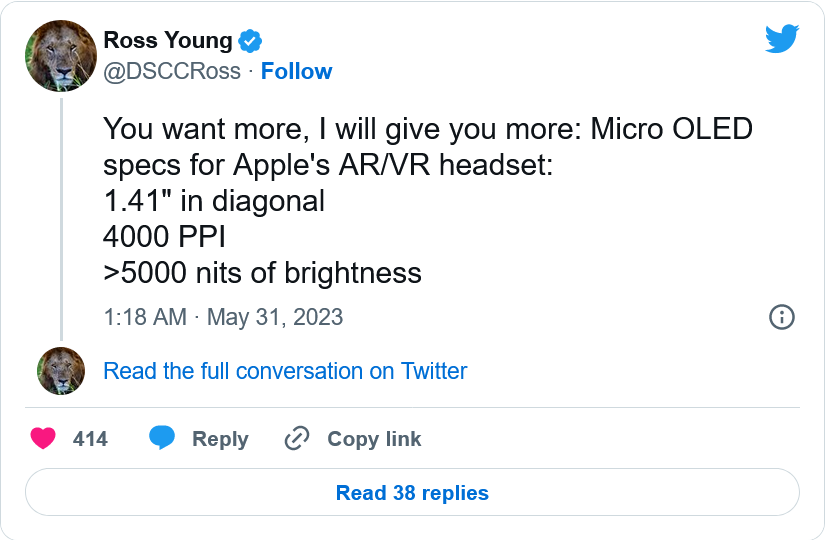

Corsair has just announced a new lineup of DDR5 RAM modules called the Corsair Dominator Titanium that offers both speed and some interesting customizable features. The Dominator Titanium RAM is designed to go up to speeds of up to 8,000MT/s. The new Corsair RAM modules will be offered for Intel’s XMP 3.0 platform when they are used with Intel’s 12th and 13th-Gen Core processors. It also will support AMD’s EXPO platform for Ryzen 7000 CPUs.(Neowin, Corsair)
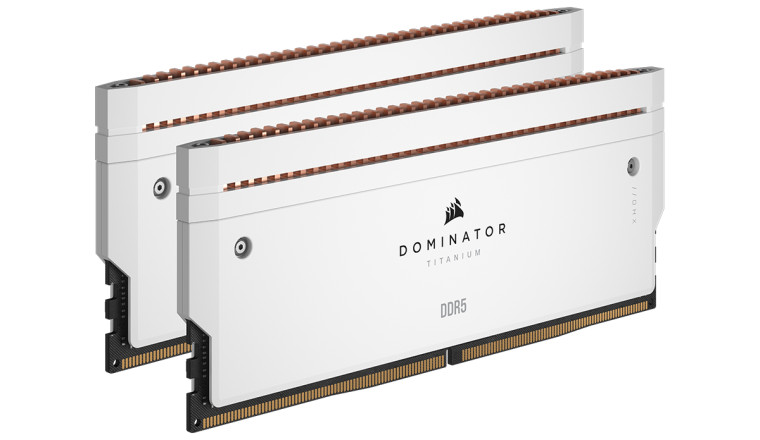

Japan and JAXA, the country’s space administration, have spent decades trying to make it possible to beam solar energy from space. In 2015, the nation made a breakthrough when JAXA scientists successfully beamed 1.8 kilowatts of power, enough energy to power an electric kettle, more than 50m to a wireless receiver. Now, Japan is poised to bring the technology one step closer to reality. A Japanese public-private partnership will attempt to beam solar energy from space as early as 2025. The project, led by Naoki Shinohara, a Kyoto University professor who has been working on space-based solar energy since 2009, will attempt to deploy a series of small satellites in orbit. Those will then try to beam the solar energy the arrays collect to ground-based receiving stations hundreds of miles away. (Engadget, Asia Nikkei)
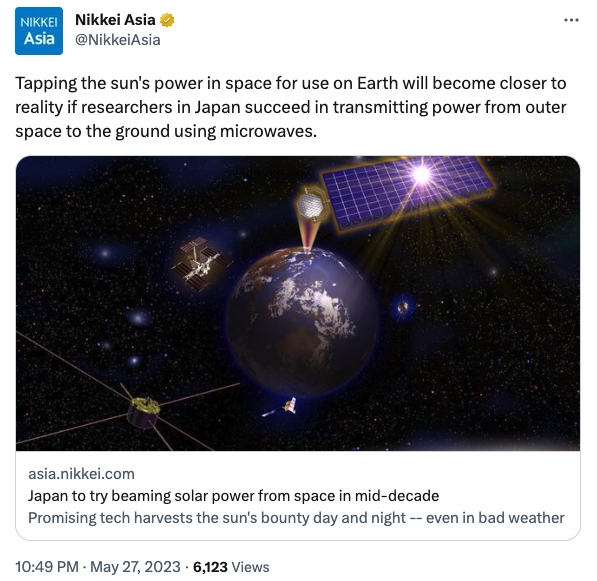
France has opened a major battery-making gigafactory. It is the first of four such plants European and Asian companies plan to build in the country. Named the Automotive Cells Company, the project is a joint venture between Stellantis, Mercedes and TotalEnergies, and it involves a total investment of USD2.2B. The French state and local authorities will provide half the funding. The new plant will start production of lithium-ion batteries later 2023 . It aims to have the capacity to fit around half a million cars a year. (CN Beta, ACC, Yahoo, Euro News)
